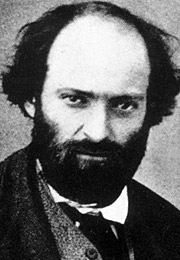


Oil on canvas
74.3 x 61.0 cm. (29 1/4 x 24 in.)
frame: 97.2 x 84.5 x 6.6 cm. (38 1/4 x 33 1/4 x 2 9/16 in.)
L1988.62.4
Jos Hessel (1859–1942), Paris, by 1914; [sold to Paul Cassirer, 31 Mar. 1914]; sold to Rudolph W. Vollmoeller, Vaihingen-Stuttgart, 18 May 1916; by descent to Hans R. Vollmoeller, Uster, Switzerland, by 1950; sold to Mr. Richard H. Zinser, Forest Hills, NY, Oct. 1950; sold to Henry Pearlman, 1 July 1952; Henry and Rose Pearlman Foundation, after 1974.
Between 1899 and 1902, Cézanne rented a storage room at the Château Noir estate, on the road from his native Aix-en-Provence to the nearby village of Le Tholonet, and often painted on the grounds. The neo-Gothic buildings of this peculiar country manor were unfinished, giving it the appearance of a ruin. The original owner, who manufactured lampblack (a type of pigment made from soot), had – according to rumor – painted the entire mansion black and practiced black magic, or sorcery, there, supplying the name “The Black Castle.”
The modern stone cistern at Château Noir seen at the left of this painting contrasts with the ancient boulder at the center; the rock’s distinctive shape suggests the flint artifacts unearthed in the region. Local mythology also had it that the surrounding archaeological attractions and strange geological formations housed magical forces.
The characteristic pine trees of Provence provided shade from the Mediterranean sun in this cool site in the deforested region, where only evergreens would grow.

Paul Cézanne (1839-1906)
Cézanne is recognized as one of the great innovators of late 19th- and early 20th-century art, whose work has influenced countless modern artists. With an introverted temperament and generally anti-establishment stance, Cézanne forged a new approach to painting that sought not only to reflect nature but also to express his own response to it. Although during his formative years he exhibited with the Impressionists, he ultimately felt at odds with their emphasis on fleeting experience, seeking greater solidity through painterly form and structure.
Born in Aix-en-Provence, Cézanne studied drawing early on, but, fulfilling his father’s wishes, he later enrolled in university to study law. In 1861, however, he left for Paris, where he studied at the Académie Suisse and copied Romantic and Baroque art at the Louvre. Failing to gain entrance to the École des Beaux-Arts, and constantly rejected by the official Salon, Cézanne rebelliously painted in an intense, even violent, manner, with thickly encrusted paint. Finding a mentor in the Impressionist painter Camille Pissarro, in the 1870s Cézanne lightened his palette and started working directly from the landscape. He was influenced by the solidity of Pissarro’s brushwork and compositional structure, yet, like Paul Gauguin, whom he met in 1880, he sought to express his own personal perceptions and sensations through his views of nature.
By the late 1870s, Cézanne’s paintings showed increasing emphasis on mass and structure, and he developed a system of parallel brushstrokes, known as his “constructive stroke,” that conveyed the volume of both form and space. With mind and eye working in concert, Cézanne built up his pictures slowly and deliberately, often while directly confronting his motif, whether a landscape, still-life, or portrait. In Aix, the prominent form of Mont Sainte-Victoire became one of his dominant motifs from the mid-1880s until the end of his life. Attracted to its enduring geometric form and the changing views offered by different light and angles, Cézanne created more than thirty paintings in oil and watercolor that conveyed his intense examination of the subject’s underlying structures as well as the shifting nature of perception.
Cézanne used the medium of watercolor to experiment with form and structure, creating a wide range of effects through transparent planes of color and strokes of pencil. The exceptional luminosity of watercolor allowed him to play with light as a constructive element, while often using blank passages of paper to heighten the sense of space and form. Cézanne’s watercolors thus had a great influence on his oil paintings, seen particularly in his use of exposed areas of blank canvas as a constitutive element and passages that reveal open compositional structures, as exemplified in Route to Le Tholonet. Many successive generations of artists, from the Cubists and Fauvists to Abstract Expressionists, would be influenced by Cézanne’s experimental legacy.